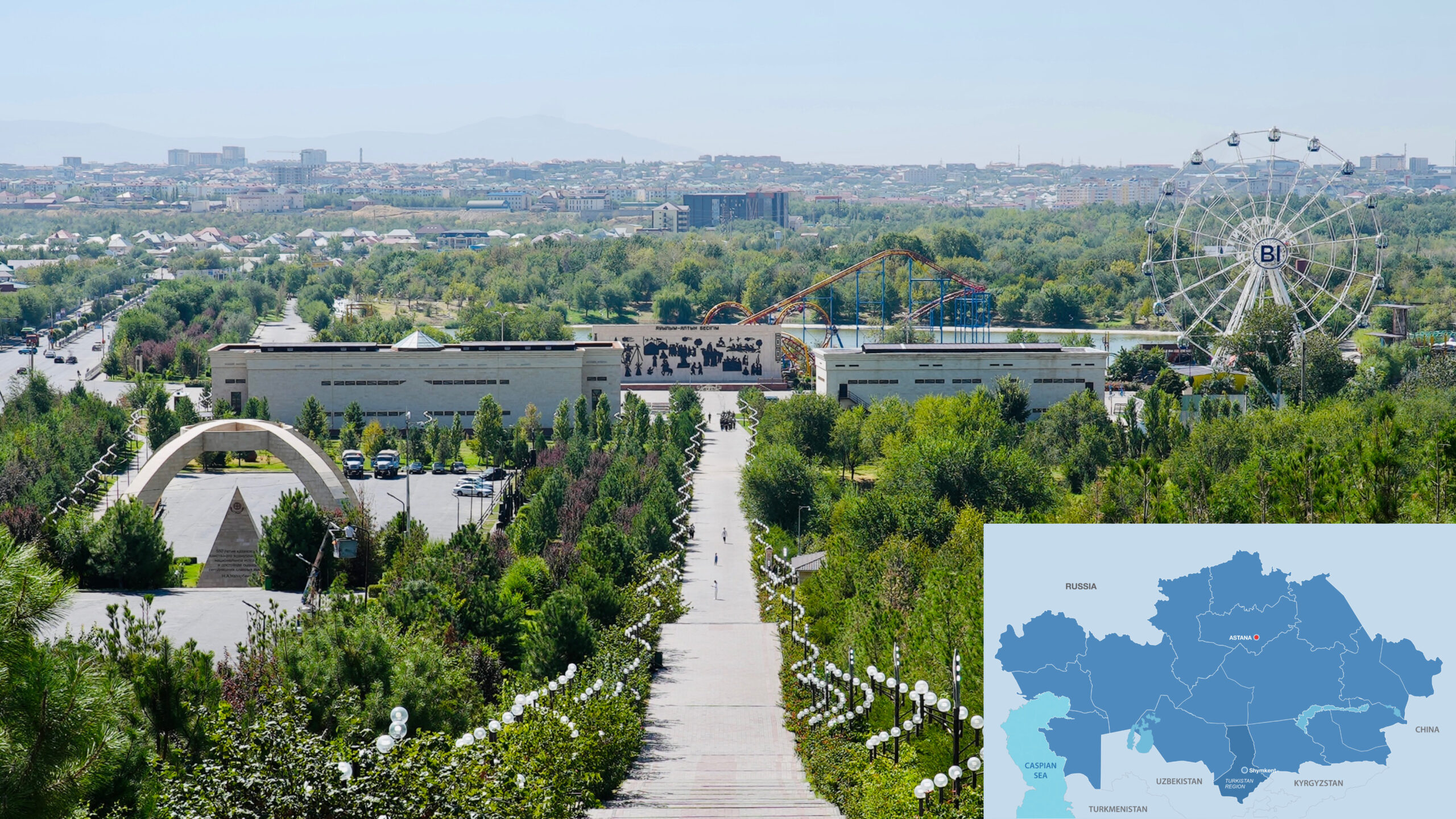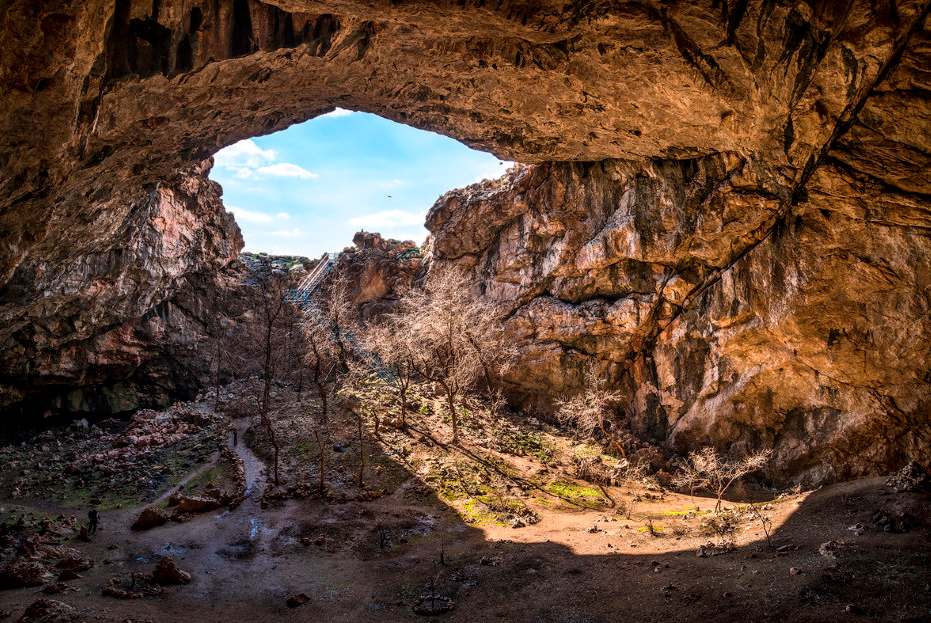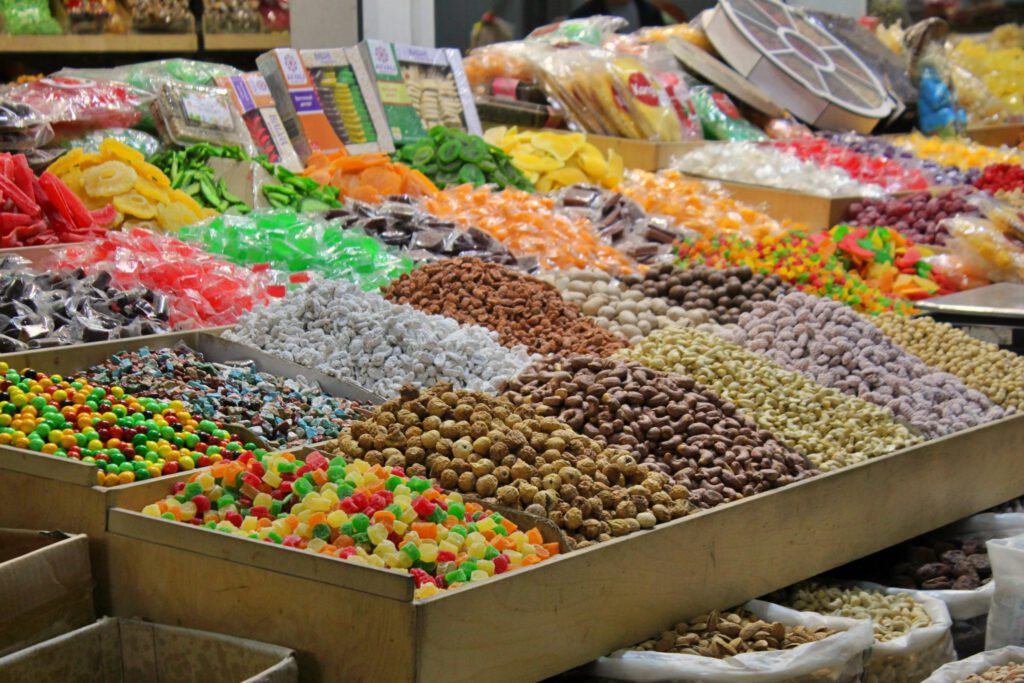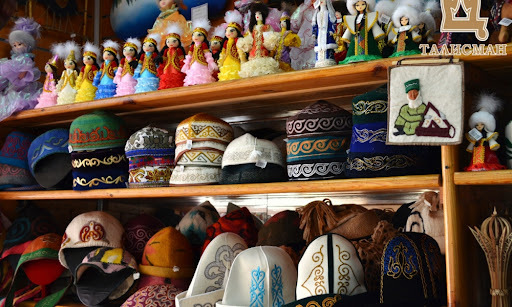Editor’s Note: The Astana Times introduces a new series, Exploring Kazakhstan, City by City. We are setting out to unveil the rich diversity of Kazakhstan’s cities. Starting with Zhezkazgan, we continue our journey in the wonderful city of Shymkent. By exploring each city’s unique history and culture, we aim to bring you closer to the heart and soul of Kazakhstan.
ASTANA — A city of national significance, situated in the south of Kazakhstan, Shymkent stands as one of the nation’s foremost industrial and economic hubs. With its rich history intertwined with the Silk Road, Shymkent beckons visitors on a journey through time, from the ancient city of Sayram to its modern-day allure.

Shymkent. Photo credit: gov.kz. Click to see the map in full size. The map is designed by The Astana Times
Translated from Farsi and partially from Turkic as a green city, Shymkent lives up to its name. Beautiful greenery adorns its landscapes and gardens, casting a serene atmosphere across the city.
“Shymkent holds a special place in the spiritual life of our people. It embodies the best features of the Kazakh character. (…) In the glorious land of Shymkent, our nation was formed,” said President Kassym-Jomart Tokayev during the meeting with the Shymkent’s public on Sept. 27, 2022.
The city’s long history has given rise to remarkable historical landmarks, tracking back to activities dating back to the Bronze Age and its emergence as a caravansaray along the Silk Road in the 11th century.
Throughout the centuries, the city was captured by Genghis Khan in 1219, later by Tamerlane, the Dzungars, the Kokand and Bukhara Khanates, and the Russian Empire in July 1864. Despite that, Shymkent has preserved itself, evolving from a small settlement into a thriving industrial, commercial, and cultural center.
Sights to behold in Shymkent
Among Shymkent’s notable attractions are its vibrant parks, including Ken Baba Park, Independence Park, Abai Park, Metallurgist’s Park, Kiyal Alemi (Fantasy World) Techno Park, Shamshi’s World, and Dendropark. Each park has its own unique history, atmosphere, and thematic appeal.

Dendropark. Photo credit: The-steppe
The Dendrological Park, established in 1979, showcases over 600 species of herbaceous plants on the territory. Visitors can explore a diverse array of flora and fauna, including peacocks, squirrels, and spotted deer. Additionally, the park offers recreational activities such as pedal boating on its picturesque lake and biking along designated trails.
Located in the heart of Shymkent, Abai Park provides a calm retreat. It features attractions such as the Museum of Modern Arts, which showcases Kazakh culture from ancient times to the present, and the Khakim Abai Museum, which houses a collection of personal items belonging to the esteemed Kazakh poet and philosopher Abai Qunanbaiuly.
Shymkent’s historical treasures
The citadel of Shymkent is a historical and cultural open-air complex that served as a fortress and armed military base to defend Sayram city on the Silk Road. According to archaeologists, the history of Shymkent likely originated in this area.
Restored to its original grandeur, the citadel spans nearly five hectares, featuring landmarks such as the Stairway of Hope, the Tower of Love, and the Tower of Alchemists. In 2023, the ancient citadel’s exhibition halls and archaeological sites in Shymkent welcomed at least 40,000 visitors, where tours are conducted in four languages – Kazakh, English, Russian and Chinese.

Abdul-Aziz Baba Mausoleum. Photo credit:onecountrymore.com
Further afield lies the historical city of Sayram, a 3,000-year-old settlement located in the eastern part of Shymkent. Renowned as one of Kazakhstan’s oldest continuously inhabited cities, Sayram served as a pivotal trade and cultural hub along the Silk Road. Today, it draws tourists and pilgrims from around the world with its cluster of mausoleums, including Ibrahim Ata and Karashash-Ana Mausoleums, the mausoleums of famous Sufi Khoja Ahmed Yassawi’s parents.
Additionally, visitors can explore the Abdel-Aziz Bab and Mirali-Baba Mausoleums, the Kydyr Minaret and the Monument of Khojasalyk, all of which contribute to the city’s rich cultural heritage.
Shymkent’s hidden gems
The Domalak-Ana Mausoleum, located in the Karatau area in the valley of the Balabogen River, stands as an architectural monument built over the burial site of Ali Nurily Sylankyzy, known as Domalak-Ana for her small features.
Another version comes from the Persian “Dihnat mom,” meaning Holy Mother. According to legends, there are two sacred stones in the mausoleum, and only a righteous person can pass between them. Locals tell wonderful stories about families that visited Domalak-ana Mausoleum to ask for the blessing and eventually had their long-awaited children.

Sayram-Ugam national park. Photo credit: Yerbolat Shadrakhanov / Shutterstock
For centuries, the Domalak-Ana mausoleum was rebuilt several times and did not retain its true appearance, but the museum preserved a large number of manuscripts.
One of the most mysterious places near Shymkent is the underground Akmeshit (white mosque in Kazakh) cave situated 80 kilometers from the city. The cave is a unique natural object not only in terms of its scale but also in its unique appearance. The panorama opening from the cave resembles a Kazakh yurt’s shanyraq.

Underground Akmeshit (white mosque in Kazakh) cave. Photo credit: Qazaqsatan 3D
According to locals’ stories, women and children sought shelter in the cave during the Dzungar invasion. Another legend tells of an ancient dragon that once inhabited the cave, attacking people and animals. As the dragon stretched its wings, it brushed against the cave walls, causing the opening to grow larger over time. However, the legend goes that the prophet Suleiman eventually tamed the dragon by chaining it up.
Another hidden gem and a must-destination for nature lovers, fans of hiking, and wildlife enthusiasts seeking to explore natural beauty and cultural heritage is Sayram-Ugam national park.
It is a world-renowned national park, established in 2006, located 70 kilometers south of Shymkent in the rugged Western Tian Shan mountains. The park offers ten equestrian and hiking routes 604 kilometers long, 187 kilometers of hiking trails, 231 kilometers of horseback, and 186 kilometers of car routes.
Bazaars: a taste of traditions
A visit to Shymkent’s bustling bazaars is essential to experiencing the vibrant ambiance of traditional southern Kazakhstan. Among the city’s renowned markets is the Qyrgy bazaar or Upper bazaar, located between Ordabassy Square and Shamshi’s World. Here, vibrant colors, spices, and endless rows of sweets and fruits await visitors.

Qyrgy Bazaar sweets and nuts. Photo credit: Info Shymkent
For those in search of affordable clothing and an extensive selection of fabrics, yarns, and sewing accessories, the Bekzhan bazaar offers a wealth of options. Meanwhile, the Samal bazaar attracts with its exquisite display of gold and silver jewelry, adding a touch of shimmering elegance to the vibrant marketplace.
Getting around and accommodation
Shymkent International Airport, located approximately 11 kilometers from the city center, offers convenient access for travelers. Transportation options such as buses, taxis and car rentals are readily available, providing connectivity to the city and its surroundings for considerably cheaper prices than the ones in Astana or Almaty.
For accommodations, Shymkent offers a range of options, from budget-friendly hostels to luxury chains of hotels such as Rixos Khadisha Shymkent and DoubleTree by Hilton Shymkent. Online platforms such as Booking.com and Airbnb provide convenient booking options, perhaps with a higher chance of getting service in English. Alternatively, there are local platforms such as Krisha.kz, with individual owners offering affordable housing options.
Souvenirs to treasure
In Shymkent, renowned for its craftsmanship, visitors can find showcasing local artistry made of felt, silk, and real leather. The most popular items are felt slippers, toy camel figures, traditional yurts, Kazakh dolls adorned in traditional attire, and figures of traditional Kazakh instruments.

Kazakh souveniers. Photo credit: talismans.kz
One can buy handmade silver and gold souvenirs such as earrings, bracelets, necklaces, rings and other pieces of jewelry in Kazakh national style. Additionally, traditional clothing such as chapan (a traditional gown), camisoles (traditionally styled jacket or vest) and embroidered takiya (skullcap) serve as charming reminders of Shymkent’s cultural legacy, making them ideal gifts to cherish.

